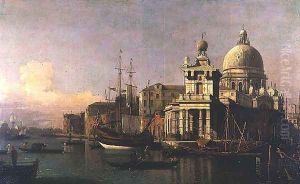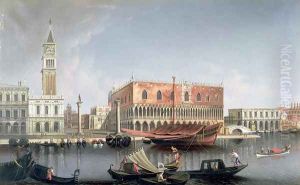Manner of Canaletto, Antonio Paintings
Antonio Canal, better known as Canaletto, was an Italian painter born in 1697 in Venice, a city that would become central to his artistic legacy. He was initially trained by his father, Bernardo Canal, a theatrical scene painter, which helped him develop an early interest in perspective and architectural subjects. Canaletto's work, however, would soon transcend the confines of theatre settings, capturing the essence of Venice in a manner that no artist had before. His meticulous cityscapes and views of Venice's canals, piazzas, and festivals not only showcased his remarkable precision and command over light and shadow but also his ability to infuse vibrancy into the static architecture of the city. These works gained him international recognition, particularly among the British clientele, leading to a significant period of his career spent in England from 1746 to 1755.
During his stay in England, Canaletto painted numerous scenes of London and the English countryside, applying the same keen observation and detailed execution that characterized his Venetian views. Despite the change in locale, his works continued to be celebrated for their clarity, accuracy, and ability to capture the atmosphere of the scene. On returning to Venice, Canaletto found that the city had changed, and the demand for his views had declined. This period saw a shift in his style, with a looser brushwork and a greater focus on atmospheric effects, possibly influenced by the works of his nephew and pupil, Bernardo Bellotto, who was also a notable vedute (view painting) artist.
Canaletto's legacy is profound, influencing not only the genre of vedute but also the way Venice was perceived by the world. His paintings served as a window to the beauty and architectural marvel of Venice for those who had never visited, and his influence extended well into the 19th century, inspiring the Romantic and Impressionist movements. Canaletto's meticulous documentation of Venice has also provided historians with valuable insights into the city's 18th-century appearance. He passed away in 1768 in Venice, leaving behind a body of work that continues to be celebrated for its precision, beauty, and historical value.

